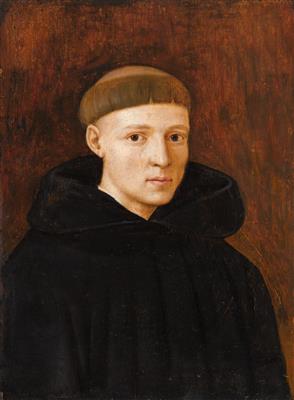Circle of Jean Fouquet

(Tours circa 1425 - circa 1478)
Portrait of a Young Monk
oil on panel, 30 x 22 cm, framed
Provenance:
with Sackville Gallery, London (1921);
with, J. Goudstikker, Amsterdam (1923);
with P.De Boer, Amsterdam (1949);
with Galerie Pardo, Paris (1950);
European Private Collection.
The present painting, was formerly attributed to the Flemish School of the late 15th century. Its Flemish features are not, however, exclusive, and are combined with other elements indicating its belonging to the French art milieu around the mid-15th century.
The half figure of the young monk stands out against the brown background of the wall, illuminated by a light source coming from the left. The powerful realism of the face, the execution of the shades as well as the shape of the broad pleats in the tunic indicate a direct knowledge of the masters of Flemish painting in the first half of the 15th century, from Jan Van Eyck to Roger Van der Weyden and Petrus Christus.
However, the painting’s pronounced monumental features, its frontal arrangement and a larger execution of the modelling show considerable links with Jean Fouquet’s style and especially strong affinities to the works of the Master of René of Anjou, identified as Barthélemy d’Eyck, the great artist of Flemish origin who was active in the South of France. Also very evident are the similarities, in both style and pictorial execution, to the Portrait of a Man, dated 1456, conserved in the Liechtenstein Museum, Vienna, which has been attributed to this painter and regarded as one of the masterpieces of 15th-century French painting.
21.10.2014 - 18:00
- Stima:
-
EUR 50.000,- a EUR 70.000,-
Circle of Jean Fouquet
(Tours circa 1425 - circa 1478)
Portrait of a Young Monk
oil on panel, 30 x 22 cm, framed
Provenance:
with Sackville Gallery, London (1921);
with, J. Goudstikker, Amsterdam (1923);
with P.De Boer, Amsterdam (1949);
with Galerie Pardo, Paris (1950);
European Private Collection.
The present painting, was formerly attributed to the Flemish School of the late 15th century. Its Flemish features are not, however, exclusive, and are combined with other elements indicating its belonging to the French art milieu around the mid-15th century.
The half figure of the young monk stands out against the brown background of the wall, illuminated by a light source coming from the left. The powerful realism of the face, the execution of the shades as well as the shape of the broad pleats in the tunic indicate a direct knowledge of the masters of Flemish painting in the first half of the 15th century, from Jan Van Eyck to Roger Van der Weyden and Petrus Christus.
However, the painting’s pronounced monumental features, its frontal arrangement and a larger execution of the modelling show considerable links with Jean Fouquet’s style and especially strong affinities to the works of the Master of René of Anjou, identified as Barthélemy d’Eyck, the great artist of Flemish origin who was active in the South of France. Also very evident are the similarities, in both style and pictorial execution, to the Portrait of a Man, dated 1456, conserved in the Liechtenstein Museum, Vienna, which has been attributed to this painter and regarded as one of the masterpieces of 15th-century French painting.
|
Hotline dell'acquirente
lun-ven: 10.00 - 17.00
old.masters@dorotheum.at +43 1 515 60 403 |
| Asta: | Dipinti antichi |
| Tipo d'asta: | Asta in sala |
| Data: | 21.10.2014 - 18:00 |
| Luogo dell'asta: | Wien | Palais Dorotheum |
| Esposizione: | 11.10. - 21.10.2014 |
